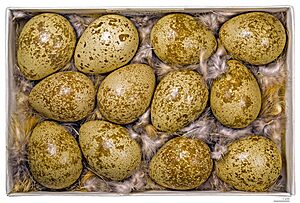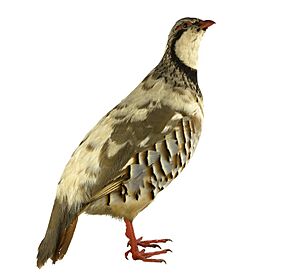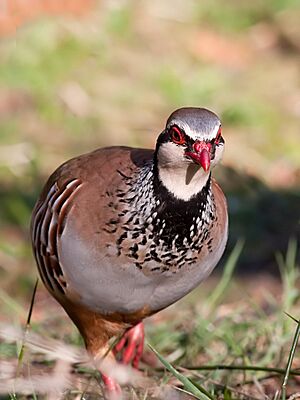Red-legged partridge facts for kids
Quick facts for kids Red-legged partridge |
|
|---|---|
 |
|
| Conservation status | |
| Scientific classification | |
| Genus: |
Alectoris
|
| Species: |
rufa
|
| Synonyms | |
|
Tetrao rufus Linnaeus, 1758 |
|
The red-legged partridge (scientific name: Alectoris rufa) is a type of bird often hunted for sport or food. It belongs to the pheasant family, which includes chickens and turkeys. People sometimes call it the French partridge to tell it apart from the grey partridge, which is found in England. The name Alectoris comes from an old Greek word for a farm chicken, and rufa is Latin for red.
This bird is round and has a light brown back. Its chest is grey, and its belly is a buff color. Its face is white with a black band around its throat, like a necklace. It also has red stripes on its sides and bright red legs. When it feels in danger, it usually runs away instead of flying. But if it needs to fly, it can go a short distance on its rounded wings.
Red-legged partridges mostly eat seeds. However, young partridges need to eat insects. Insects give them important protein to grow. The sound they make is a three-part call that sounds like ka-chu-chu.
Contents
Where Do Red-Legged Partridges Live?
This partridge naturally lives in southwestern Europe. You can find it in countries like France, Spain, Portugal, and northwest Italy. It has also been brought to England and Wales. There, it lives in flat areas and is hunted for sport. Sometimes, it has even been seen breeding as far north as Scotland.
In southeastern Europe, you will find a very similar bird called the rock partridge. The red-legged partridge does not migrate, meaning it stays in the same area all year. Outside of the breeding season, these birds often gather in groups.
They like to build their nests on the ground in dry, flat areas. This includes farmland and open, rocky places. Sometimes, they even share their homes with wild rabbits!
Different Types of Red-Legged Partridges
There are three main types, or subspecies, of the red-legged partridge. These types are slightly different depending on where they live:
- One type lives in northern and western Spain and Portugal.
- Another type lives in eastern and southern Spain and the Balearic Islands.
- The third type, which is the original one, lives in France, northwest Italy, and some islands like Elba and Corsica.
What Do Red-Legged Partridges Look Like?
Adult red-legged partridges are sandy-brown on their backs. Their bellies are a pinkish-buff color, and their chests are light grey. They have a clear black stripe around their throat. Their sides have bold red and black stripes. Their throat is cream-colored, and their legs are pink. They also have a red beak and a red ring around their eyes.
The top of their head and the back of their neck are a warm pinkish-brown. The front and sides of their head are pale blue-grey. They have a thin off-white stripe above their eyes. There is a solid black line of feathers above a patch of pinkish-red skin near their eyes. This black color continues behind the eye, gets wider, and then goes down around the throat to meet the black stripe.
Their chin and upper throat are creamy-white. A solid black band borders this area. This black color continues down the lower throat as black streaks on a pale sandy-grey background. Similar, but thinner, black streaks are on the sides of their upper neck. The lower neck sides are a warm pinkish-brown.
Their flanks (sides) have bright reddish-brown stripes, usually eight to ten of them. Each stripe has a thin black edge. The area in front of each stripe is off-white, and behind it is pale grey. The upper parts of their body are plain, dark sandy-grey. Their tail feathers are a pinkish-red color.
Their beak is bright red, their eyes are medium brown, and their legs are pinkish-red.
Red-Legged Partridges as Food
Red-legged partridges are raised on farms for hunting. After they are hunted, they are sold and eaten as a type of wild meat, often called "game."
Red-Legged Partridges in Great Britain
The red-legged partridge naturally lives in France, Spain, and Portugal. But in the 1700s, people brought them from France to Great Britain. Since then, they have become an important bird for hunting there. Because they are from a warm, dry climate, they do well in hot, dry areas with sandy soil.
These birds can lay two sets of eggs at the same time. This makes them easy to raise in captivity and release for hunting. It is against the rules to breed chukar partridges or mixes of chukar and red-legged partridges. This is to protect the wild red-legged partridge populations. Sadly, the number of red-legged partridges is thought to be decreasing in many places.
Red-Legged Partridges in New Zealand
Many red-legged partridges are kept and bred in special bird enclosures in New Zealand. Their population there is currently considered safe. All these birds are descendants of a group of eggs sent from the United Kingdom in 1980.
About 1500 eggs were sent, but they got too hot and were delayed. Only 135 chicks hatched from this first group. Later, more eggs were sent, but only a few chicks hatched from those too. The plan was to raise these birds and have them breed many times. However, the program ended, and the birds were sent to other breeders. By 1983, the population had grown to 940 birds.
It is not clear how many wild red-legged partridges live freely in New Zealand today. Most of them are kept by people who raise birds or on game farms. Some zoos and farm parks also have them. People in New Zealand do not often eat this bird.
A similar bird, the chukar partridge, is not allowed to be kept in captivity in New Zealand. It has lived in the wild on the South Island since the 1930s. However, the number of chukar partridges has been going down since the late 1980s. Other birds introduced for hunting in New Zealand include bobwhite quail, brown quail, California quail, guinea fowl, blue peafowl, wild turkey, and pheasant. People put a lot of effort into managing the populations of more popular hunting birds like bobwhites and pheasants.
Images for kids







